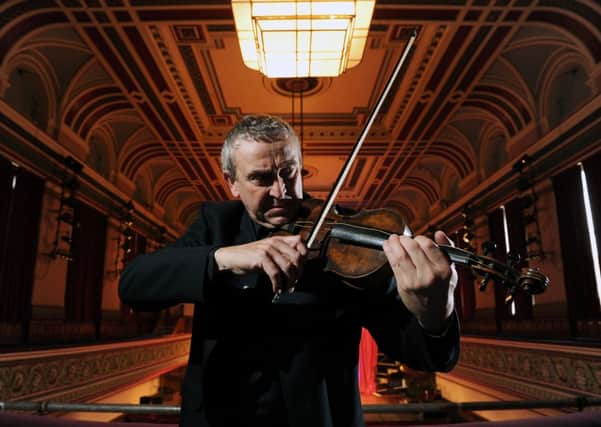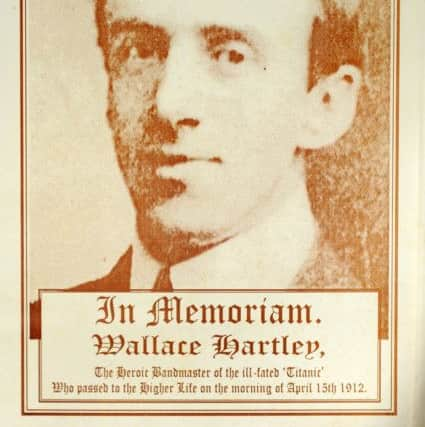Final trip home for ‘holy grail’ of Titanic artefacts


Now the violin belonging to the ship’s band master, Wallace Hartley, has returned to his home town of Dewsbury for the first time in more than a century.
The musician and the other seven members of his orchestra – who carried on playing to calm passengers as the lucky ones were herded into lifeboats – were among more than 1,500 people who perished after the vessel struck an iceberg in April 1912.
Advertisement
Hide AdAdvertisement
Hide AdBut incredibly, the instrument – found strapped to the 24-year-old’s body in his leather luggage case – survived relatively unscathed despite spending 10 days in the Atlantic.


The violin, described as the “holy grail” of Titanic relics, was at Dewsbury Town Hall yesterday in its last public showing before it is sold at auction this weekend.
The instrument, on which survivors said he led the hymn Nearer, my God, to thee as the stricken ship went down, is expected to fetch between £200,000 and £300,000.
Andrew Aldridge, a chartered valuation surveyor with auctioneer firm Henry Aldridge and Son, said: “The Wallace Hartley Titanic violin is one of the most iconic collectables from the 20th century.
Advertisement
Hide AdAdvertisement
Hide Ad“Hartley was an incredibly brave man whose actions helped to calm passengers during Titanic’s last hours.
“After being approached by Kirklees Council, we felt it only appropriate that the violin come home to Yorkshire and the town where Wallace Hartley chose to live for one last time.”
The German rosewood violin, given to him as engagement gift by his fiancée, Maria Robinson, in 1910, was, until the last decade, widely thought to have been lost.
It was not listed in the official inventory of items found in his possession after his body was recovered by a Canadian crew.
Advertisement
Hide AdAdvertisement
Hide AdBut a telegram sent by Miss Robinson, who lived in Boston Spa, to officials in Nova Scotia reveals it was sent to her. In it, she expresses her “heartfelt thanks” for its safe return.
She never married and later moved to Bridlington, where she died from stomach cancer aged 59 in 1939.
The violin and case were given to the Bridlington Salvation Army, whose leader, a Major Renwick, passed them on to one of his members, a local music and violin teacher.
It was later given to a member of the Women’s Auxiliary Air Force who was stationed in the town in the 1940s.
Advertisement
Hide AdAdvertisement
Hide AdIn a note attached to it, the teacher told her: “Major Renwick thought I would be best placed to make use of the violin but I found it virtually unplayable, doubtless due to its eventful life.”
The instrument’s survival only came to wider attention in 2006 when her son, who inherited it years later, contacted Henry Aldridge and Son, who specialise in selling Titanic memorabilia.
Seven years of forensic testing and historical research followed before its authenticity was finally confirmed in May.
Government forensic scientists concluded corrosion deposits on it were “considered compatible with immersion in sea water”.
Advertisement
Hide AdAdvertisement
Hide AdAn expert from the Gemological Association of Great Britain also confirmed a silver plate on the base of the violin was an original fixture and the engraving was contemporary with hallmarks made in 1910.
“The authentication process behind the collection has been a long and exhaustive one with some of the world’s leading experts in their respective fields helping to assemble a conclusive package of independent reports to accompany the archive,” said Mr Aldridge.
The violin, which will go under the hammer on Saturday at Henry Aldridge and Son’s auction house in Devizes, Wiltshire, has attracted interest from collectors all over the world. It was viewed by more than 315,000 people during a three-month exhibition in the US before moving on to Belfast, where the Titanic was built, for three and a half weeks ahead of yesterday’s final showcase in Dewsbury.
Lancashire-born Hartley, who was a member of Huddersfield Philharmonic Orchestra, was living in West Park Street, Dewsbury, before he died.
Advertisement
Hide AdAdvertisement
Hide AdThe town honoured him last month with the long-awaited opening of a bandstand in his name in Longcauseway Memorial Gardens.
Paul Kane (Lab, Dewsbury East), chairman of Dewsbury Regeneration Board, said: “He may not have been born in Dewsbury but he lived here.
“In the 1920s his family were promised a bandstand and now we have delivered, nearly 100 years on.”